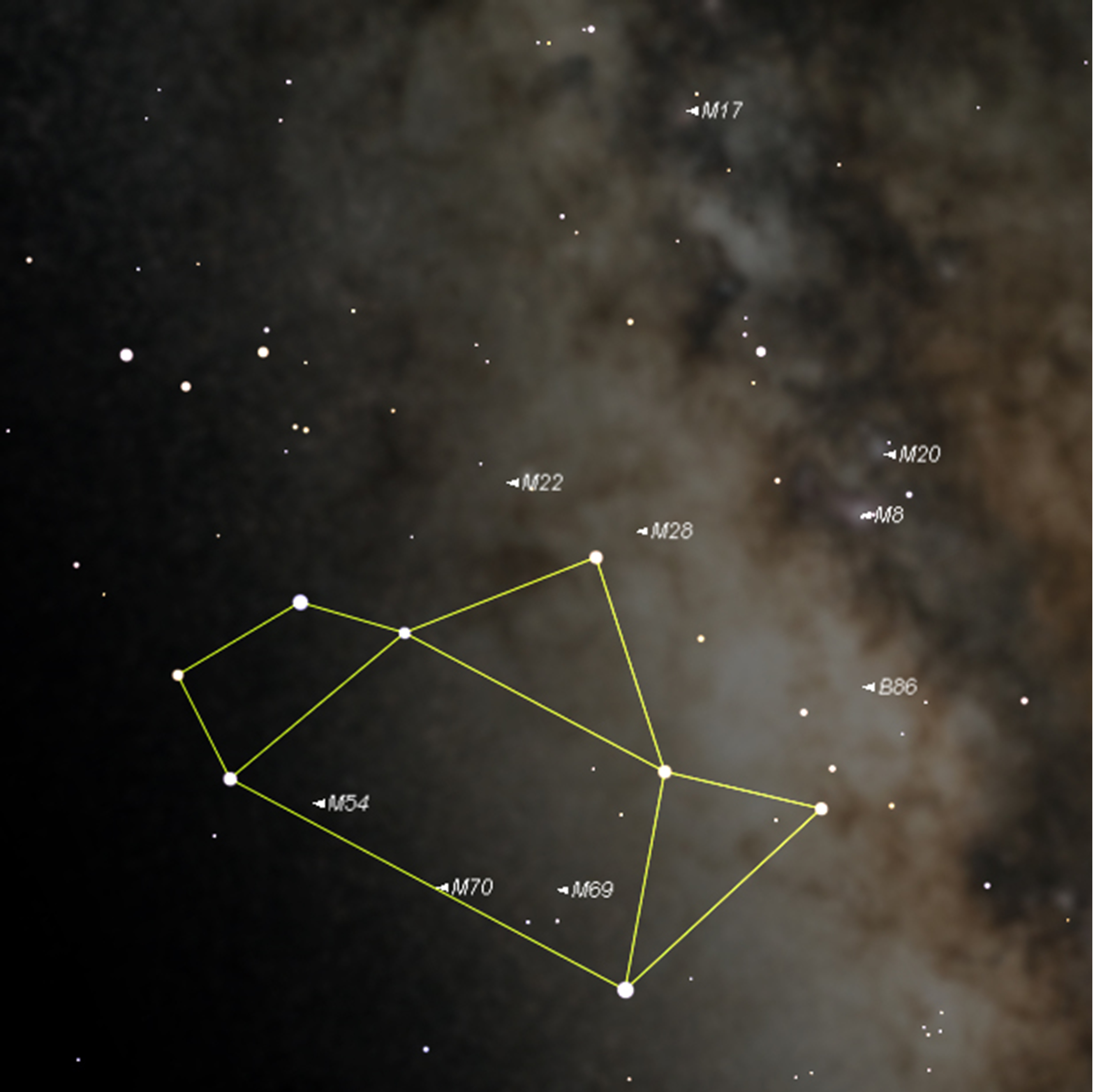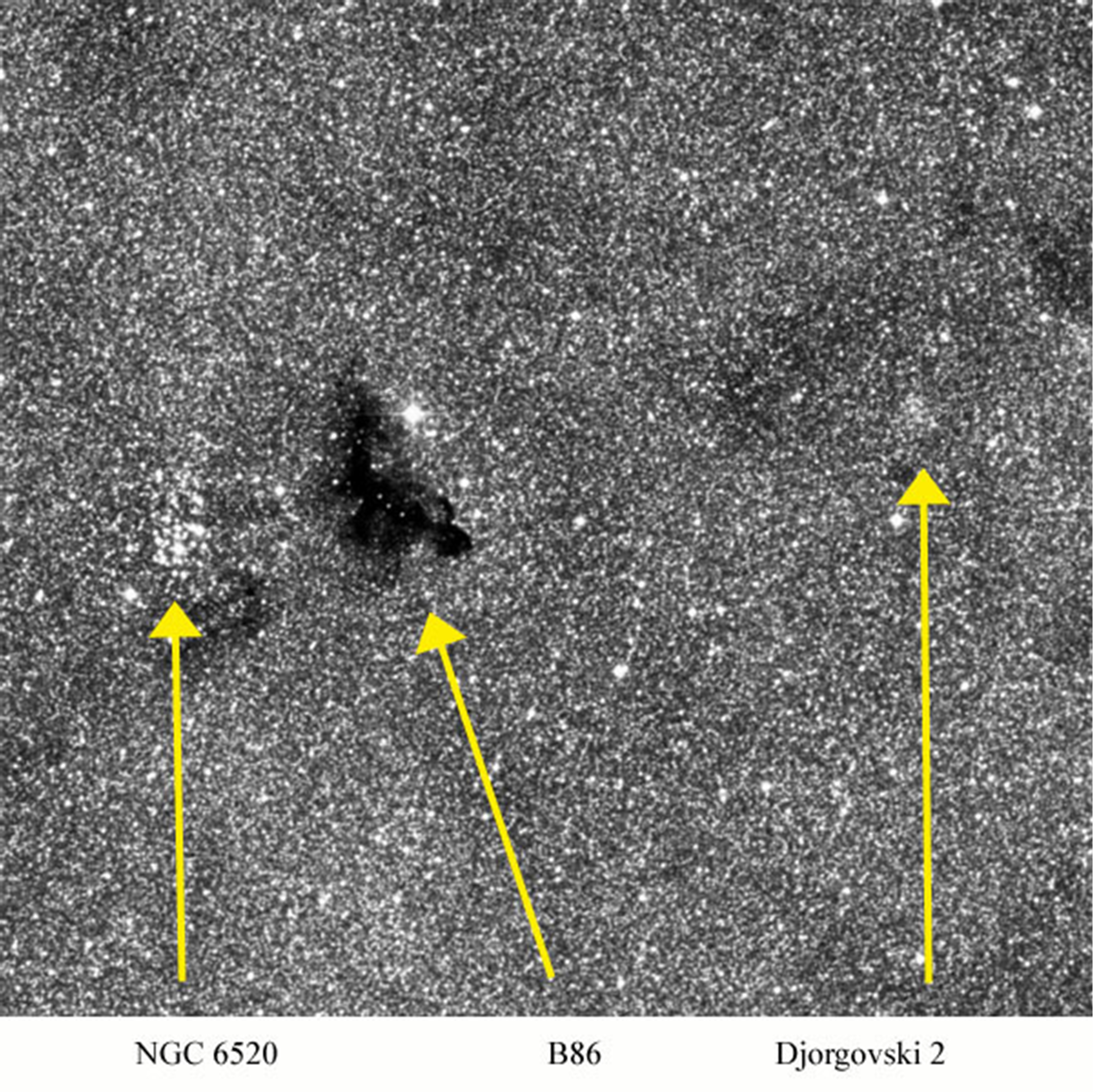
As the summer Milky Way whirls past this time of year, the heart of our galaxy comes into prime position. Get yourself away from city lights, to the darkest place you can, and look at the band of the Milky Way arcing overhead from its dim northeastern reaches in Perseus, through its sugary texture and dark rifts of Cygnus overhead, to its brilliant thickness around Sagittarius, Ophiuchus and Scorpius deep in the south. It is often overlooked that the most impressive view you can have in astronomy is that of our own galaxy, with nothing more than our eyes-no telescope or binoculars required.
However, treasures await those who probe the Milky Way more deeply, and that's where binoculars or a telescope are invaluable. This month, let's look at some interesting sights in the heart of the Milky Way, in and around the Teapot asterism in the constellation Sagittarius. The Teapot is transiting (at its highest point above the horizon) just before midnight. This is as good as it gets for Sagittarius; astronomically dark, and transiting.
Let's explore. Here is a chart of the Teapot area in Sagittarius, with choice targets marked:
The Milky Way is rich in globular clusters surrounding the core of the galaxy. The center of the galaxy is off the tip of the spout, just about where the star is, to the right of B86. The Teapot asterism hosts five bright globular clusters, and many others that can be seen in a modest size telescope (six inches), and numerous challenge globulars for large aperture amateur telescopes.
This area is also replete in nebulae. M8 is an easy and beautiful combination of an open cluster with an emission nebula, named the Lagoon Nebula. Nearby is M20, or the Trifid Nebula, and while a bit more challenging, M20 combines dark nebulae along with an open cluster in a striking manner, and both emission and reflection nebulae.
Since I've mentioned dark nebulae, we can visit one of the most dazzling, B86, and note a few treats very close by.
Of the globular clusters, M22 is the most impressive in this area. Look at it as darkness is setting in, during twilight, and the red giant stars will stand out. Wait for dark, and you'll find a large beehive of stars. At a mere 10,600 light years distant, it is one of the closest objects of this type. It is such a bright object that if it were located higher in the sky for those of us in the northern hemisphere, it could be seen without optical aid, at a brilliant magnitude 5.1! With an overall size of 32 arcminutes, it is slightly larger in diameter than the Full Moon. This image from the National Optical Astronomical Observatory shows many more stars than you'll find in your telescope, but your view won't disappoint.
Don't let the "M" designation fool you. Although it is included in the famous Messier catalog, its discovery occurred 100 years earlier, in 1665, by Abraham Ihle. The object continues to be of scientific interest, as two black holes with 10-20 solar masses have been discovered by the Very Large Array in New Mexico. Astrophysicists used these discoveries to theorize that the cluster contains between 5 and 100 black holes.
Make sure to visit the other globular clusters I've mentioned, they are unique in size, brightness and stellar concentration. So much to see! Oh, before I forget, M54 is most interesting. It is thought to possibly be the core of a nearby galaxy named the Sagittarius Dwarf Elliptical Galaxy (SagDEG), 87,000 light years distant. If correct, it would be the first object in our galaxy to be "reassigned" in status to another galaxy.
Jeff Young of Ireland is an outstanding observer, and drew this wonderful sketch of The Lagoon Nebula, M8. You can see how he notates his drawings. This view is rather low power, at 100 times magnification (x), and from a dark site indicated by the SQM reading (electronically measuring darkness).
In the drawing, which is fairly representative of what you can expect to see in a telescope, you can see the open star cluster, most condensed to the left of center, the milky-looking clouds to the cluster's right is the emission nebula (stellar nursery) and tight knot of stars, from which the rest of the open cluster emerged.

This is another example of a Messier object that was discovered prior to Charles Messier cataloguing "non-comets" (Messier was a comet hunter in Paris). The discovery dates 1654, by the Italian astronomer Giovanni Hodierna. It was easy to see this glowing region at magnitude 6 and a huge 90x40 arc-minutes (three times the width of a Full Moon)-from dark skies it would be very obvious. Relatively close, at 4,000 to 6,000 light years, the nebula is 110 by 40 light years in size. The distance to the last planet in our solar system is measured in light hours.
As you can note, Jeff Young used a filter (UHC) to enhance the contrast. Recommendations are to use an Orion Ultrablock when viewing M8. You'll see it without a filter, but on targets such as this, and the Trifid (M20) or Swan (M17) Nebulae, the filter really shows its value.
The last target is a challenge and a treat. B72 is an entry in the catalog of Dark Nebulae by E.E. Barnard, who did his work at Lick Observatory on Mount Hamilton in California (where I am fortunate enough to be a docent). The nebulae were catalogued via photographic plates, which you can see archived here: http://tinyurl.com/pz4xk5a.
Here is the dark nebula, B86, in the thick of the dense center of the Milky Way galaxy.
Its location just above the spout of the Teapot makes it relatively easy to find. When you do, you're going to be stunned at the denseness of the field, the darkness of the "Ink Spot".
The view of B86 is mesmerizing, as in combination with the small but dense open cluster NGC 6520 and the bright star bordering the dark nebula, appearing much like a jewel set with two contrasting components. The dark spot's edges seem to snake off into the adjacent star field, while the cluster seems to almost want to seep into the blackness.
You do not need a big telescope to see this view, but you will need dark skies. It is somewhat of a challenge object as a pair. But to extend your challenge, look for this familiar type object close by: a small patch of unresolved light was discovered by S. George Djorgovski in 1986 on photographic plates from the Southern European Observatory. The next year it was reclassified as a globular cluster (by Djorgovski) based on its "color magnitude diagram". At magnitude 9.9 and "only" 20,500 light years away, it seems it would be bright, but it is truly a dim haze. See for yourself, it's easy to locate from the pretty pair it's nearby, and it has been reported to have been viewed in an 8" telescope.
Clear skies,
Mark Wagner
Teapot image from Starry Night Pro. M22 image courtesy NOAO. M8 sketch from Jeff Young. B86 region from The STScI Digitized Sky Survey.
Mark Wagner is a life-long astronomy enthusiast and deep sky observer. He has spent the past twenty years popularizing amateur astronomy in the San Francisco bay area through his writing and community building. A past president of the San Jose Astronomical Association, he founded what is now the annual Golden State Star Party in California. Leave your comments or questions for Mark Wagner in the comments section below, and submit your sketches or images of the targets mentioned to the Orion Image Gallery.






 /
/ 









